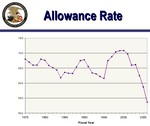Rethinking the backlog
Posted by J Matthew Buchanan at February 9, 2007 02:13 PM
Doug and I were fortunate to be invited to speak at the recent Corporate Patent Congress in New York City. Even without our meeting with Bill Patry at Google regarding his rethinking of the legal treatise and the quick jaunt we made to the Apple Store, the trip would have been an amazing success because the conference itself was very rewarding.
The small group attending the conference packed a punch - generating some amazing discussions on all things patent law, including legislative patent reform efforts and recent judicial activity. Thanks, in large part, to the wonderful pairing of Nick Godici (ex-Commissioner for Patents ) and John Love (current Deputy Commissioner for Patent Examination Policy), a significant portion of the discussions focused on Patent and Trademark Office efforts to implement change.
In his talk, Deputy Commissioner Love presented the graph at right that shows  the dramatic dropoff in the allowance rate over the last several years. In explaining the dropoff, he stressed several new "quality initiatives" being implemented at the Office, including the mysterious and frequently-fatal "second pair of eyes" policy (have you been caught by this one yet?). Deputy Commissioner Love clearly draws a connection between the allowance rate dropoff and PTO examination "quality initiatives."
the dramatic dropoff in the allowance rate over the last several years. In explaining the dropoff, he stressed several new "quality initiatives" being implemented at the Office, including the mysterious and frequently-fatal "second pair of eyes" policy (have you been caught by this one yet?). Deputy Commissioner Love clearly draws a connection between the allowance rate dropoff and PTO examination "quality initiatives."
But, to me, that graph shows something entirely different. Perhaps because I've yet to see a dramatic increase in examination quality, I think the graph really highlights the degree of control the Office has over the backlog of applications.
Think about it. Have you abandoned more cases over the last couple years as you've fought the so-called allowance rate? Or have you simply pursued other prosecution options, such as Pre-Appeal Brief Conferences, full appeals, and continuation filings? I'd be surprised if the abandonment rate has increased as dramatically over the last couple years. If it hasn't, as I suspect, the allowance rate dropoff directly feeds into the backlog.
Here's the troublesome part. The application backlog can be, and has been, used for a variety of political purposes, including anti-fee diversion, outsourcing, inter-Office partnerships, and administrative rule changes. Perhaps more troublesome is the fact that the application backlog is often cited as evidence of the need for major patent policy changes (think the "alternative patent products" mentioned in the strategic plan and even several of the proposed legislative changes). It's even possible that the Supreme Court might look at the backlog as it considers its stance on obviousness in the KSR v. Teleflex case.
So what's the point? Simple...policy-makers, including legislators, administrators, and judges, need to be careful out there. Before justifying any major policy change with the growing backlog, a thorough examination of the reasons for its growth should be conducted. Heck, a congressional investigation might be warranted. They might just find that all that glitters is not gold.



 J. Matthew Buchanan
J. Matthew Buchanan  Stephen M. Nipper
Stephen M. Nipper  Douglas Sorocco
Douglas Sorocco 
Trackback
You can ping this entry by using http://www.phlexability.com/mt/mt-tb.cgi/637 .
Comments
russ schultz Says:
February 10, 2007 12:26 PM
i think what is shows is a mechanical rejection policy pased on the following steps.
1. read claims.
2. do mechical word search
3. find refereces with all words
4. reject cases based on 103 based on references
5. get response
6. do second word search based on any amendments to claims and ignore arguments
7. finally reject claims on 103 based on mindless application "second search required by applicants amendment"
8. get disposal
Norton R. Townsley Says:
February 10, 2007 09:12 PM
Not sure what the graph says. But Russ is absolutely right on the examination process. Except I think Examiners only compare the drawings in the references to the claim elements. I wish I had a nickel for each time I have read that the applicant's arguments are unpersuasive.